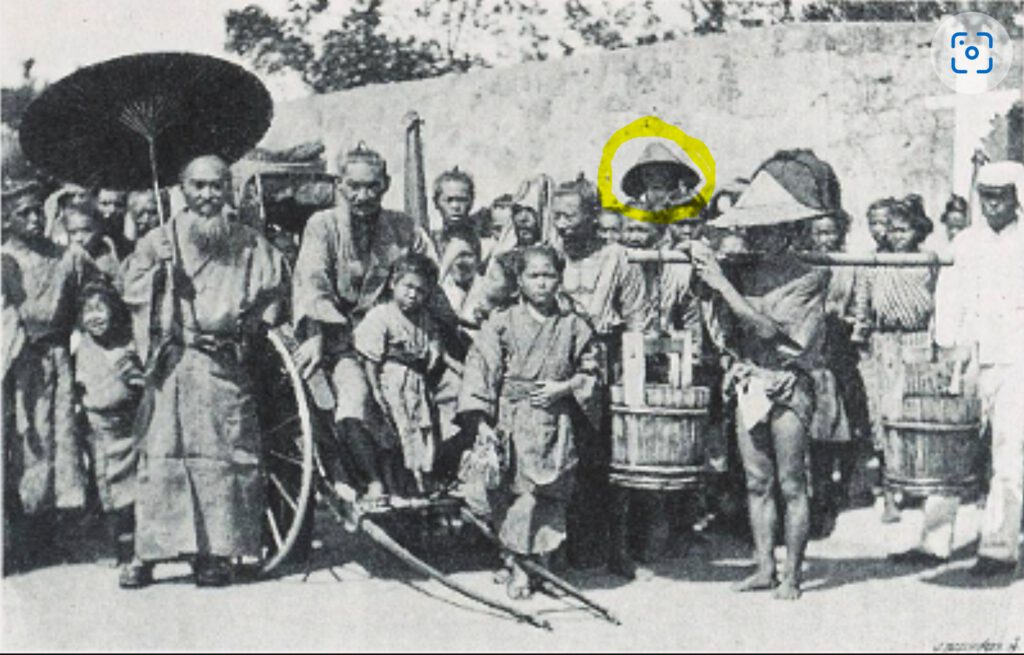(The following is an episode translated from the stories of the late Kinjo Hiroshi Sensei himself, found on his website)
There was a famous master of the fist named Motobu Chōki. Even among the younger generation, those who are training in karate probably know his name.
It would be appropriate to describe my encounter with Motobu Chōki as a coincidence. As I will write about in detail in the following, I first met him through a hole in a paper sliding door when I was six years old.
One of my childhood friends, who was one or two years older than me, was Tomiyama Gorō. Although he died young due to childhood tuberculosis, he always wanted to stand over me no matter what. Not only because he was older, but also because my face always looked pale and I coughed a lot, and I was a little underdeveloped and not physically confident, so with the wisdom of an elder, it was obvious that he always wanted to lead me.
One day, Gorō came to call me. He told me that Motobu Sārū was coming to his house and that he would show him to me. Gorō’s house was the third next door. He hurried along and told me that Motobu Sārū was in the front parlor and that I should peek through the hole in the paper sliding door. Even as a child, I felt some resistance and hesitation at the idea of peering through the hole. However, with the joy of being able to see the face of the great pugilist I had always admired, I gathered my courage and peeked into the parlor through a hole in the paper sliding door, following Gorō’s instructions.
In the middle of the front parlor was a middle-aged man with a stern face, sitting cross-legged with his arms crossed. My first impression was that he had a slightly scary face and he didn’t seem cheerful. Even though we met through a hole in the paper sliding door, Motobu had no idea who we were. I think he probably thought of it as nothing more than a child’s prank. However, this was very satisfying. Later, I would tell my friends that I had met Motobu Sārū.
Thirteen or fourteen years after this encounter, I happened to meet Motobu Sārū again at my maternal grandfather’s house, and had the opportunity to have a conversation with him for the first time. It appears that my maternal grandfather and Motobu Sārū knew each other, and although my maternal grandfather was older, he spoke to Motobu in courteous language. At that time, I was a senior in middle school, a member of the karate club, and had been practicing karate for over ten years. However, I don’t remember him talking much about karate.
What I do remember is that he made a one-knuckle-fist with his right hand and said, “Let’s strike the pillar with a one-knuckle-fist. It will make a dent in the pillar!” Generally speaking, a one-knuckle-fist is one with the middle finger held up, but Motobu’s one-knuckle-fist had the index finger stick out. This unexpected matter left a strong impression on me. However, neither my grandfather nor I wanted him to perform striking the pillar with his one-knuckle-fist.
After that, about two years later, on October 20, 1938, I had a rare opportunity to attend the dedication demonstration at the Okinawa Shrine Festival. I had heard from my maternal grandfather that Motobu was said to be an unparalleled great master of the fist, but that he was actually a coward and that half of his victories were achieved due to deception.
There was a rumor that he had won against many opponents by deception, so I decided to check it out. I asked him timidly and modestly if this was true, and he he spat out at me that it was the fault of those who were deceived. At the time, I could not agree with those words. I thought he was just the man as the rumors had said. However, about half a century later, I came to realize that he had deceived me. So, he showed off his deception skills by saying “It’s the fault of those who are deceived,” while this is actually an expression of “deception is also part of the skill.”
Translator’s addendum
I have a few questions here.
- Was the alleged cowardice a story of tactics and strategies, such as described by Jesse here, when Motobu was already 72 years old, facing a mad attacker with a butcher knife?
- Did it change Kinjo’s interpretation of karate after he finally understood the importance of Motobu’s lesson 50 years later?
- If Sun Tsu famously said “All warfare is based on deception,” and Miyamoto Musashi also used trickery, why is it considered wrong?
- Kinjo traced his karate theory back to Matsumura Sokon, but never considered Motobu Choki, a direct student of Matsumura, even tough “Watashi no Karatejutsu” became public in the 1990s. Why?
© 2023, Andreas Quast. All rights reserved.

